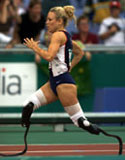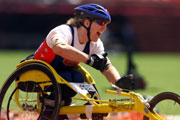Track Events
Description
The track events are divided into
sprint events,
semi-endurance
(middle distance) events,
endurance (long
distance) events,
events outside the
stadium, and relay events (team events).

Sprint events include:
 |
The 100 m event. It is the shortest distance in
sprint events. Every athlete runs in his own lane
(color). |
|
 |
The 200 m event. The 200 m is the modern
equivalent of the ancient “stadium” event of 192.27
m. Many 100 m athletes also compete in the 200 m
event, since these two events require similar
abilities. |
 |
The 400 m event. It involves total coverage of
the perimeter of the stadium and is considered an
extended speed event. The 400 m is the modern
equivalent of the ancient “diavlos” event of 2 x
192.27 m. |
|
The middle-distance or
semi endurance events
include:
 |
The 800 m event. This distance combines speed and
endurance as well as tactics with athletes completing
two laps of the stadium. |
 |
 The
1,500 m event. Many 800 m athletes also compete in the
1,500 m since these two events require similar
abilities. The
1,500 m event. Many 800 m athletes also compete in the
1,500 m since these two events require similar
abilities. |
The endurance events
include:
 |
The 5,000 m event. This event is similar to the
“Dolikhos” of the ancient Olympic Games which consisted
of twenty-five laps of the stadium (approximately 4,800
m). |
 |
The 10,000 m event. It is the longest distance run
inside the stadium. |
The relay events consist of
the:
 |
4 x 100 m event and |
 |
4 x 400 m event |
Relay events can be traced to the ancient custom of
sending messages via a series of couriers (skytalodromi or
‘runners with a message stick’). Each courier handed the
stick over to the next until its destination was safely
reached. In the relay event there are four runners from each
country. Each runner covers a part of the distance before
handing over the baton to the next runner. Changeovers have
special rules and techniques and must be made within a
specified area.
 Men’s
and Women’s Marathon constitutes the Paralympic Games
road events. The Marathon
is run over public roads. In 2004 the Marathon will be run
on the 26 September on its historic course (42,195 m),
starting in the town Marathonas and finishing in the
Panathinaiko Stadium. Men’s
and Women’s Marathon constitutes the Paralympic Games
road events. The Marathon
is run over public roads. In 2004 the Marathon will be run
on the 26 September on its historic course (42,195 m),
starting in the town Marathonas and finishing in the
Panathinaiko Stadium.
Rules
The rules and regulations governing Olympic Games track
events are also valid for the Paralympic Games, with certain
variations per class. The most important ones are the
following:
In classes 32 to 34
(athletes with cerebral palsy) and
51 to 54 (athletes with spinal cord injuries),
athletes compete in a special competition wheelchair which
must comply with certain specifications. More specifically,
it must have two large wheels of up to 70 cm in diameter and
at least one smaller wheel of maximum 50 cm diameter.
Furthermore, in the 800 m events and over, the starter can
interrupt the event and declare a restart (recall) if there
is a collision during the first 200 meters of the event. In
all events above 800 meters, in the 4 x 400 m relay and in
the marathon, runners must wear a helmet. Finally, during a
event the runner who follows behind bears the responsibility
of overtaking. The runner who leads must not obstruct or
block the way of his or her fellow athlete, from the moment
that the front wheels of the runner who is following behind
appear.
In classes 11 and 12
(blind), the runners are allowed to have
assistants/accompanying persons on the Field of Play. The
assistants wear a brightly colored waist-coat (gilet) so
they can be distinguished from the blind runners. From the
100m to the 400m event, class 11 and 12 athletes compete
along with an assistant (guide), in two lanes – one for the
blind runner and one for his or her assistant. Under no
circumstances is the guide allowed to lead ahead of the
athlete. If the guide finishes in front of the blind runner,
the athlete is disqualified. Finally, runners of class 11
must wear a blindfold on their eyes in all events up to
1,500 m inclusive.
In classes 35 - 38
(athletes with cerebral palsy) and
42 - 46 (athletes with amputations or other physical
disabilities), it is not compulsory for the runners to
observe the four supporting points at the starting line or
to use starting blocks. |

